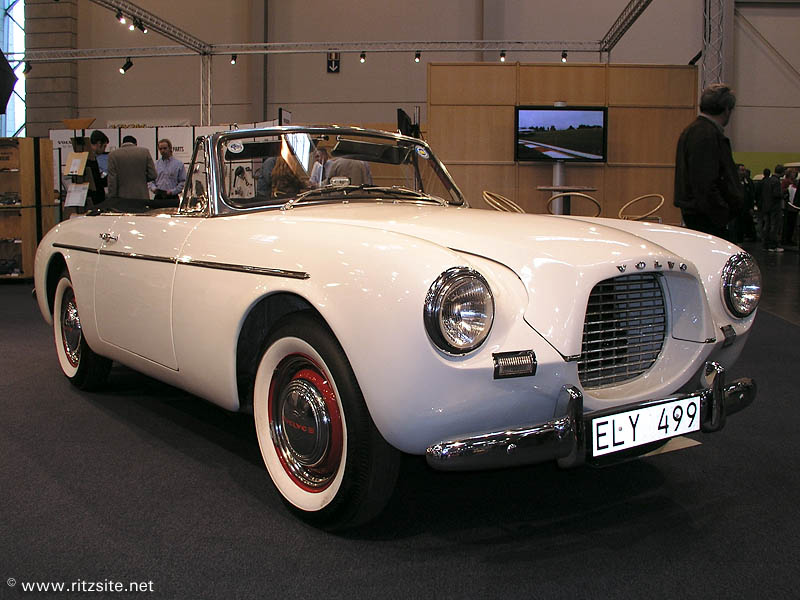|

Volvo Sport P1900 - fiberglass roadster body - manufactured in 1956
Already from the first car introduced in 1927 the cars of Swedish manufacturer Volvo have distinguished themselves as being substantial, traditional and durable. But there have been a few aberrations from that path along the years and one of the most remarkable of those was the Volvo Sport roadster. Produced in extremely low quantities it was meant to be the Swedish answer to the popular British sport cars in the USA, with a hint of Corvette thrown in for good measure, but it didn't work out that way.
Classic Volvo designs were more than inspired by American examples and subsequently the Volvo management spent quite a bit of time in the US, contacting suppliers and checking out new developments. In the early 1950s Volvo was planning to expand their market to the US and felt they needed a kind of an image maker, an appealing model that would catch the attention of the general public and establish the Volvo name. And instead of stressing the qualities Volvo was good at it was decided to join the ranks of the import sports cars, the most profitable and booming market for European imports in the US at the time. Obviously Volvo didn't have a sports car in their range of sensible vehicles so a new one had to be created, and in good Volvo tradition they looked at US cars for inspiration rather than at the rapidly selling British models.
The most advanced thing at the time was modelling car bodies from a relatively new material composed from polyester reinforced with glass fiber. Advantages were low weight, simple production, limited investment in tooling and easy molding. The car that attracted the most attention with this new kind of body construction was the Chevrolet Corvette introduced in 1953 and Volvo picked up on that. General Motors directed the interested Volvo company to a specialist firm named Glasspar in Costa Mesa. Glasspar had already a wide experience in working with fiberglass reinforced plastics, having been designing and producing boat hulls and bodies for racing cars since 1948. Arrangements between Volvo and Glasspar were rapidly made and Volvo started work on making a special chassis.
Late in 1953 a newly designed chassis was sent to Glasspar constructed of double steel tubes with rugged crossmembers and outer side members. It was fitted with the 1414 cc B14A engine with double SU carburettors and producing 70 hp @ 5500 rpm, and a slightly old fashioned 3-speed gearbox. It was left to Bill Tritt at Glasspar to design a 2-seater sports car body around it. The first prototype arrived in Sweden in 1954 and by June 1954 four prototypes could be shown to the public. In the mean time Volvo technicians learned how to work with glassfibre at Glasspar so that they would be up to the task of manufacturing the production car bodies inhouse. In January 1955 the car now baptized Volvo Sport was shown at its first car show in Brussels but then things started to get difficult.
Traditionally new Volvo models were tested thoroughly and the Volvo Sport was no exception. A long and hard test drive at the end of 1955 showed that the car lacked rigidity, resulting in all sorts of vibrations, shaking doors, a fluttering hood and cracks in the body. The car was already scheduled for production at the time so hastily some improvements were made but another test drive early in 1956 proved that it wasn't enough and that there were still quality and rigidity problems. Never the less production had started and the first cars were shipped to expecting customers. During production continuous improvements were made to the cars but Volvo was reluctant to press on in earnest with the Sport, suspecting damage to their reputation.
By the end of 1956 just 45 cars had been produced of which only a few were exported to the US. Production continued reluctantly into 1957 until new Volvo director Gunnar Engelau tested the car himself for a weekend and found it to be very unsatisfactory. He aborted the Volvo Sport program on the accounts of it being not up to Volvo quality standards and too expensive to produce. In May 1957 the last Volvo Sport was delivered after only 68 cars of the planned 300 had been manufactured in total. This didn't mean however that Volvo had given up on the idea of producing a sports car because only 3 years later the more famous P1800 coupe was introduced, a model with a traditional metal body enjoying a much longer life span and much higher production figures.
So the Volvo Sport P1900, as it's referred to in retrospect, was completely untypical for Volvo. It was not save, not rugged and not practical. In fact, it was a failure. But a pretty failure, and a step in the process of Volvo becoming a more versatile manufacturer. And as a result the majority of these rare cars were not scrapped but pampered by their owners and now about 50 of them are still extant.
You can find more in-depth info about the P1900 on Volvo Adventures.com.
© André Ritzinger, Amsterdam, Holland
|
